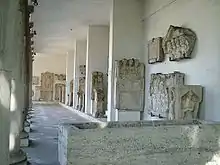
The lapidarium section in the Aquincum Museum, Budapest, Hungary
.JPG.webp)
Lapidarium with epitaphs in the Schottenstift (Scottish Abbey), Vienna
A lapidarium is a place where stone (Latin: lapis) monuments and fragments of archaeological interest are exhibited.[1]
They can include stone epigraphs; statues; architectural elements such as columns, cornices, and acroterions; bas reliefs, tombstones; and sarcophagi.
Such collections are often displayed in the outdoor courtyards of archaeology museums and history museums.
A lapidary museum could either be a lapidarium or – less often – a gem museum (e.g. the Mineral and Lapidary Museum, North Carolina).
Examples
- The Lapidarium (in the National Museum), Prague, Czechia
- The Lapidarium, Kerch, Crimea, Ukraine
- The Lapidarium of Kings, Copenhagen, Denmark
- The Museo lapidario maffeiano (museum-lapidarium of Maffei), Verona, Italy
- The Lapidary Museum, Avignon, France
- The Estense Lapidary Museum, Modena, Italy
- Split Archaeological Museum
- Samharam Lapidarium,[2] Khor Rowri, Oman.
- Memphite Lapidarium (Mit Rahina, Egypt) [3]
See also
- A glyptotheque, a sculpture museum, usually stone sculptures
References
- ↑ Desk, Web (2022-10-02). "Lapidariums: The Rich Tapestry of Historical Artifacts and Culture". Azadi Times. Retrieved 2023-11-02.
- ↑ "Samharam Archaeological Park". Madain Project. Retrieved 20 December 2023.
- ↑ "Open Air Museum and Lapidarium of Memphis". Madain Project. Archived from the original on 20 December 2023. Retrieved 20 December 2023.
External links
 Media related to Lapidariums at Wikimedia Commons
Media related to Lapidariums at Wikimedia Commons
This article is issued from Wikipedia. The text is licensed under Creative Commons - Attribution - Sharealike. Additional terms may apply for the media files.